Direct and Inverse Kinematics of a 3RRR Symmetric Planar Robot: An Alternative of Active Joints
Abstract
1. Introduction
1.1. Planar Parallel Robots
1.2. Existing 3RRR Symmetric Planar Robot Kinematic Models
1.3. 3RRR Symmetric Planar Robot Active Joints
2. Methods
- The location of the robot’s active joints was taken at joints P, D, and A, as shown in Figure 2.
- Joints Q, E, B, C, F, and R in Figure 2 are all passive joints.
- The mathematical methods implemented for model derivation are the law of cosines, trigonometric properties, geometric relations, the Pythagoras theorem, derivatives, vectors, and matrices.
- The mathematical models obtained are the workspace, the direct kinematics models, and the inverse kinematics models.
- The workspace is defined using a system of inequalities provided by the constraints from the lengths of the fully extended kinematic chains.
- The derivation of the direct kinematics model is approached via vectorial analysis.
- The inverse kinematic model is derived through the geometric method and optimization techniques.
- Model validation is achieved using MATLAB-based software corroboration.
3. Results
3.1. Workspace Definition
3.1.1. First Kinematic Chain Workspace Constraints
3.1.2. Second Kinematic Chain Workspace Constraints
3.1.3. Third Kinematic Chain Workspace Constraints
3.2. Direct Kinematics Model
3.3. Inverse Kinematics Model
Solution for and
4. Model Validation
4.1. Kinematics Model Implementations
4.2. Analysis of the Optimization of
5. Discussion
6. Conclusions
Author Contributions
Funding
Data Availability Statement
Acknowledgments
Conflicts of Interest
References
- Torres Vargas, L.Z. Introducción a la Robótica; Grupo Editorial Éxodo: Miguel Hidalgo, Mexico, 2012. [Google Scholar]
- Barrientos, A. Fundamentos de Robótica, 2nd ed.; McGraw-Hill España: Madrid, Spain, 2012. [Google Scholar]
- Cardona, M.N. Similarity law for the design and workspace optimization of 3RRR planar parallel robots. In Proceedings of the 2014 IEEE Central America and Panama Convention (CONCAPAN XXXIV), Panama City, Panama, 12–14 November 2014; pp. 1–6. [Google Scholar] [CrossRef]
- Serrano, F.; Rodriguez, B.; Cardona, M. Obtención de un Modelo Dinámico Para un Robot 3RRR Basado en Teoría de Screws. Rev. Iberoam. Autom. E Inform. Ind. 2018, 15, 384–390. [Google Scholar] [CrossRef]
- Rodelo, M.; Villa, J.; Duque, J.; Yime, E. Kinematic Analysis and Performance of a Planar 3RRR Parallel Robot with Kinematic Redundancy using Screw Theory. In Proceedings of the 2018 IEEE 2nd Colombian Conference on Robotics and Automation (CCRA), Barranquilla, Colombia, 1–3 November 2018; IEEE: Barranquilla, Colombia, 2018; pp. 1–6. [Google Scholar] [CrossRef]
- Martinez-Zamudio, P.; Gonzalez-Villela, V.J.; Lopez-Parra, M.; Ramirez-Reivich, A.C. Cinemática Diferencial de un Manipulador Paralelo Plano 3RRR-(RRR)v con Actuación Virtual Indirecta. Ing. Mec. Tecnol. Desarro. 2015, 5, 321–331. [Google Scholar]
- Zubizarreta, A.; Cabanes, I.; Marcos, M.; Pinto, C.; Portillo, E. Redundant dynamic modelling of the 3RRR parallel robot for control error reduction. In Proceedings of the 2009 European Control Conference (ECC), Budapest, Hungary, 23–26 August 2009; pp. 2205–2210. [Google Scholar] [CrossRef]
- Sheng, L.; Li, W. Optimization Design by Genetic Algorithm Controller for Trajectory Control of a 3-RRR Parallel Robot. Algorithms 2018, 11, 7. [Google Scholar] [CrossRef]
- Rodelo, M.; Polo, S.; Duque, J.; Villa, J.; Yime, E. Robust Adaptive Control of a Planar 3RRR Parallel Robot for Trajectory-Tracking Applied to Crouch Gait Cycle in Children with Cerebral Palsy. In Proceedings of the 2019 IEEE 4th Colombian Conference on Automatic Control (CCAC), Medellin, Colombia, 15–18 October 2019; pp. 1–6. [Google Scholar] [CrossRef]
- Oarcea, A.; Cobilean, V.; Stan, S.D. Trajectory planning of a 3-RRRRR planar parallel robot. In Proceedings of the 2021 9th International Conference on Modern Power Systems (MPS), Cluj-Napoca, Romania, 16–17 June 2021; pp. 1–6. [Google Scholar] [CrossRef]
- Noshadi, A.; Mailah, M.; Zolfagharian, A. Active force control of 3-RRR planar parallel manipulator. In Proceedings of the 2010 International Conference on Mechanical and Electrical Technology, Singapore, 10–12 September 2010; pp. 77–81. [Google Scholar] [CrossRef]
- Al-Mayyahi, A.; Aldair, A.A.; Chatwin, C. Control of a 3-RRR planar parallel robot using fractional order PID controller. Int. J. Autom. Comput. 2020, 17, 822–836. [Google Scholar] [CrossRef]
- Saha, S.K. Introducción a la Robótica; McGraw-Hill: México City, Mexico, 2011. [Google Scholar]
- Sierra, E.M.; Ordoñez-Avila, J.L. Mathematical Modeling of a Multi-Chamber Pneumatic Soft Actuator. Actuators 2022, 11, 221. [Google Scholar] [CrossRef]
- Wang, Y.; Wang, Y.; Mushtaq, R.T.; Wei, Q. Advancements in Soft Robotics: A Comprehensive Review on Actuation Methods, Materials, and Applications. Polymers 2024, 16, 1087. [Google Scholar] [CrossRef]
- Wong, C.C.; Tsai, C.Y.; Chen, R.J.; Chien, S.Y.; Yang, Y.H.; Wong, S.W.; Yeh, C.A. Generic Development of Bin Pick-and-Place System Based on Robot Operating System. IEEE Access 2022, 10, 65257–65270. [Google Scholar] [CrossRef]
- Amador, L.D.F.; Castillo Castañeda, E.; Laribi, M.A.; Carbone, G. Design and Analysis of VARONE a Novel Passive Upper-Limb Exercising Device. Robotics 2024, 13, 29. [Google Scholar] [CrossRef]
- Durango, S.; Restrepo, D.; Ruiz, O.; Restrepo-Giraldo, J.; Achiche, S. Symmetrical Observability of Kinematic Parameters in Symmetrical-Parallel Mechanisms. Blucher Mech. Eng. Proc. 2014, 1, 254–272. [Google Scholar] [CrossRef][Green Version]
- Chablat, D.; Wenger, P. The Kinematic Analysis of a Symmetrical Three-Degree-of-Freedom Planar Parallel Manipulator. In Proceedings of the 15th CISM-IFToMM Symposium on Robot Design, Dynamics and Control (Romansy), CISM-IFToMM, Montréal, QC, Canada, 14–18 June 2004; pp. 1–7. [Google Scholar]
- Mejia, L.; Simas, H.; Martins, D. Force Capability Maximization Of a 3RRR Symmetric Parallel Manipulator by Topology Optimization. In Proceedings of the 22nd International Congress of Mechanical Engineering (COBEM 2013), Ribeirao Preto, Brasil, 3–7 November 2013. [Google Scholar]
- Zhao, J.S.; Chu, F.; Feng, Z.J. Singularities within the workspace of spatial parallel mechanisms with symmetric structures. Proc. Inst. Mech. Eng. Part C J. Mech. Eng. Sci. 2010, 224, 459–472. [Google Scholar] [CrossRef]
- Yang, G.; Chen, W.; Chen, I.-M. A geometrical method for the singularity analysis of 3-RRR planar parallel robots with different actuation schemes. In Proceedings of the IEEE/RSJ International Conference on Intelligent Robots and System, Las Vegas, NV, USA, 25–29 October 2020; IEEE: Lausanne, Switzerland, 2002; Volume 3, pp. 2055–2060. [Google Scholar] [CrossRef]
- Lilge, S.; Nuelle, K.; Boettcher, G.; Spindeldreier, S.; Burgner-Kahrs, J. Tendon actuated continuous structures in planar parallel robots: A kinematic analysis. J. Mech. Robot. 2021, 13, 011025. [Google Scholar] [CrossRef]
- Mauzé, B.; Dahmouche, R.; Laurent, G.J.; André, A.N.; Rougeot, P.; Sandoz, P.; Clévy, C. Nanometer precision with a planar parallel continuum robot. IEEE Robot. Autom. Lett. 2020, 5, 3806–3813. [Google Scholar] [CrossRef]
- Nuelle, K.; Sterneck, T.; Lilge, S.; Xiong, D.; Burgner-Kahrs, J.; Ortmaier, T. Modeling, calibration, and evaluation of a tendon-actuated planar parallel continuum robot. IEEE Robot. Autom. Lett. 2020, 5, 5811–5818. [Google Scholar] [CrossRef]
- Zaccaria, F.; Briot, S.; Chikhaoui, M.T.; Idà, E.; Carricato, M. An analytical formulation for the geometrico-static problem of continuum planar parallel robots. In Proceedings of the ROMANSY 23-Robot Design, Dynamics and Control: Proceedings of the 23rd CISM IFToMM Symposium 23, Sapporo, Japan, 20–24 September 2020; Springer: Berlin/Heidelberg, Germany, 2021; pp. 512–520. [Google Scholar]
- Chen, G.; Kang, Y.; Liang, Z.; Zhang, Z.; Wang, H. Kinetostatics modeling and analysis of parallel continuum manipulators. Mech. Mach. Theory 2021, 163, 104380. [Google Scholar] [CrossRef]
- Briot, S.; Goldsztejn, A. Singularity conditions for continuum parallel robots. IEEE Trans. Robot. 2021, 38, 507–525. [Google Scholar] [CrossRef]
- Shao, Z.; Xie, G.; Zhang, Z.; Wang, L. Design and analysis of the cable-driven parallel robot for cleaning exterior wall of buildings. Int. J. Adv. Robot. Syst. 2021, 18, 1729881421990313. [Google Scholar] [CrossRef]
- Mattioni, V.; Ida’, E.; Carricato, M. Design of a planar cable-driven parallel robot for non-contact tasks. Appl. Sci. 2021, 11, 9491. [Google Scholar] [CrossRef]
- Sun, C.; Gao, H.; Liu, Z.; Xiang, S.; Yu, H.; Li, N.; Deng, Z. Design and optimization of three-degree-of-freedom planar adaptive cable-driven parallel robots using the cable wrapping phenomenon. Mech. Mach. Theory 2021, 166, 104475. [Google Scholar] [CrossRef]
- Ji, H.; Shang, W.; Cong, S. Adaptive synchronization control of cable-driven parallel robots with uncertain kinematics and dynamics. IEEE Trans. Ind. Electron. 2020, 68, 8444–8454. [Google Scholar] [CrossRef]
- Yamine, J.; Prini, A.; Nicora, M.L.; Dinon, T.; Giberti, H.; Malosio, M. A planar parallel device for neurorehabilitation. Robotics 2020, 9, 104. [Google Scholar] [CrossRef]
- Cardona Gutierrez, M.N. Dimensional Synthesis of 3RRR Planar Parallel Robots for Well-Conditioned Workspace. IEEE Lat. Am. Trans. 2015, 13, 409–415. [Google Scholar] [CrossRef]
- Cero, I. Ejemplo de Aplicación de Cinemática Directa e Inversa a un Manipulador de 2 Grados de Libertad. 2016. Available online: https://www.researchgate.net/profile/Isra-Cero/publication/308102263_Ejemplo_de_aplicacion_de_cinematica_directa_e_inversa_a_un_manipulador_de_2_grados_de_libertad/links/57d9df0e08ae6399a39ae4e5/Ejemplo-de-aplicacion-de-cinematica-directa-e-inversa-a-un-manipulador-de-2-grados-de-libertad.pdf (accessed on 10 January 2024).
- García-Samartín, J.F.; Barrientos, A. Kinematic Modelling of a 3RRR Planar Parallel Robot Using Genetic Algorithms and Neural Networks. Machines 2023, 11, 952. [Google Scholar] [CrossRef]
- Apostolescu, T.C.; Cartal, L.A.; Udrea, I.; Ionascu, G.; Bogatu, L. Command and Control System of a Planar Parallel Robot for PCB Processing Operations. In Proceedings of the 2022 14th International Conference on Electronics, Computers and Artificial Intelligence (ECAI), Ploiesti, Romania, 30 June–1 July 2022; pp. 1–6. [Google Scholar] [CrossRef]
- Acevedo, M.; Orvañanos-Guerrero, M.T.; Velázquez, R.; Arakelian, V. An Alternative Method for Shaking Force Balancing of the 3RRR PPM through Acceleration Control of the Center of Mass. Appl. Sci. 2020, 10, 1351. [Google Scholar] [CrossRef]
- Shoaib, M.; Asadi, E.; Cheong, J.; Bab-Hadiashar, A. Cable Driven Rehabilitation Robots: Comparison of Applications and Control Strategies. IEEE Access 2021, 9, 110396–110420. [Google Scholar] [CrossRef]
- Zou, Q.; Yi, B.J.; Zhang, D.; Shi, Y.; Huang, G. Design and Kinematic Analysis of a Novel Planar Parallel Robot With Pure Translations. IEEE Access 2024, 12, 9792–9809. [Google Scholar] [CrossRef]
- Ordoñez-Avila, J.L.; Cardona, M.; Aguilar, D.A.; Ordoñez, M.; Garzón-Castro, C.L. A Novel Monitoring System for Contagious Diseases of Patients using a Parallel Planar Robot. In Proceedings of the 2022 IEEE International Conference on Machine Learning and Applied Network Technologies (ICMLANT), Soyapango, El Salvador, 15–16 December 2022; pp. 1–6. [Google Scholar] [CrossRef]
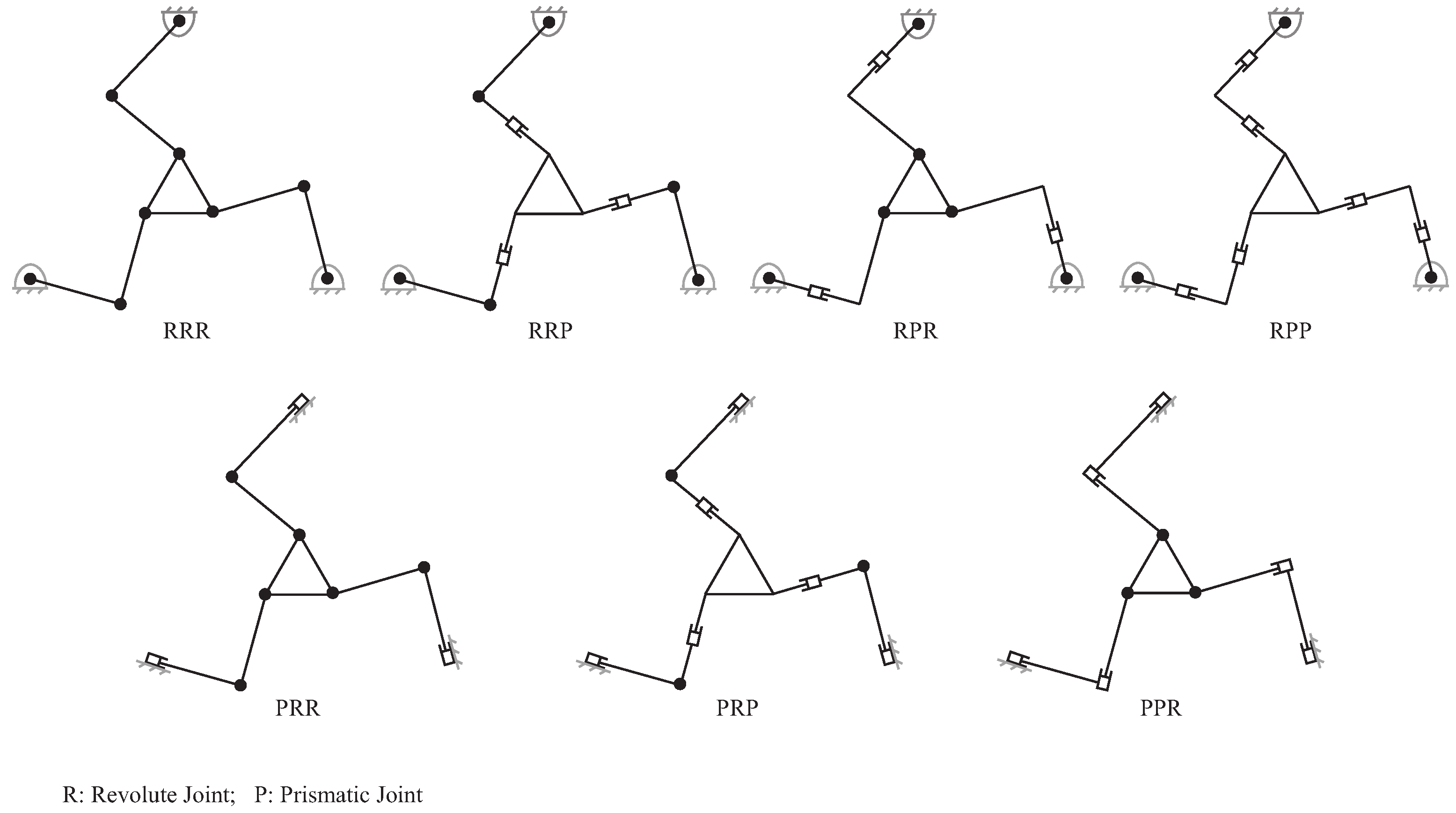
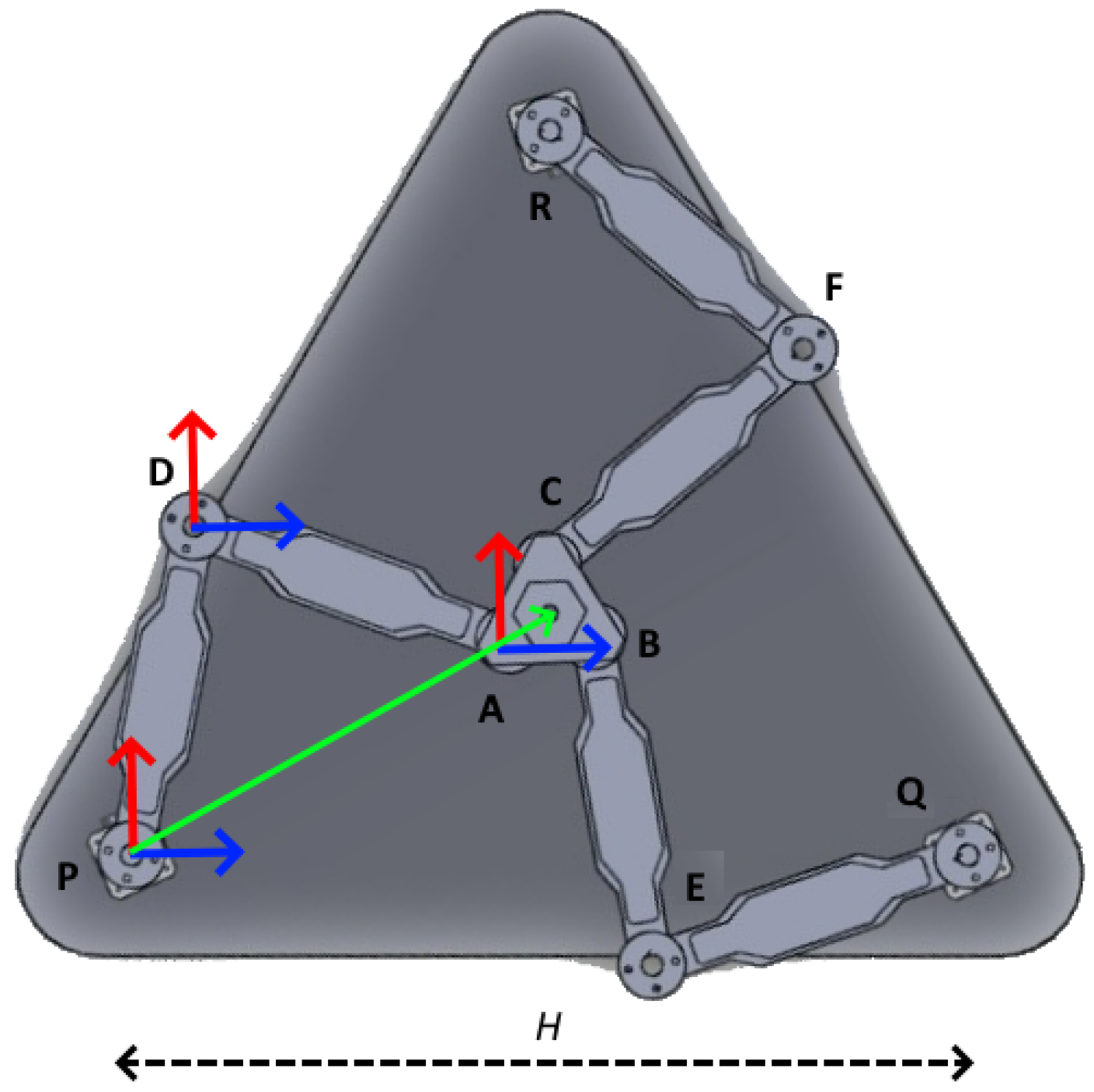
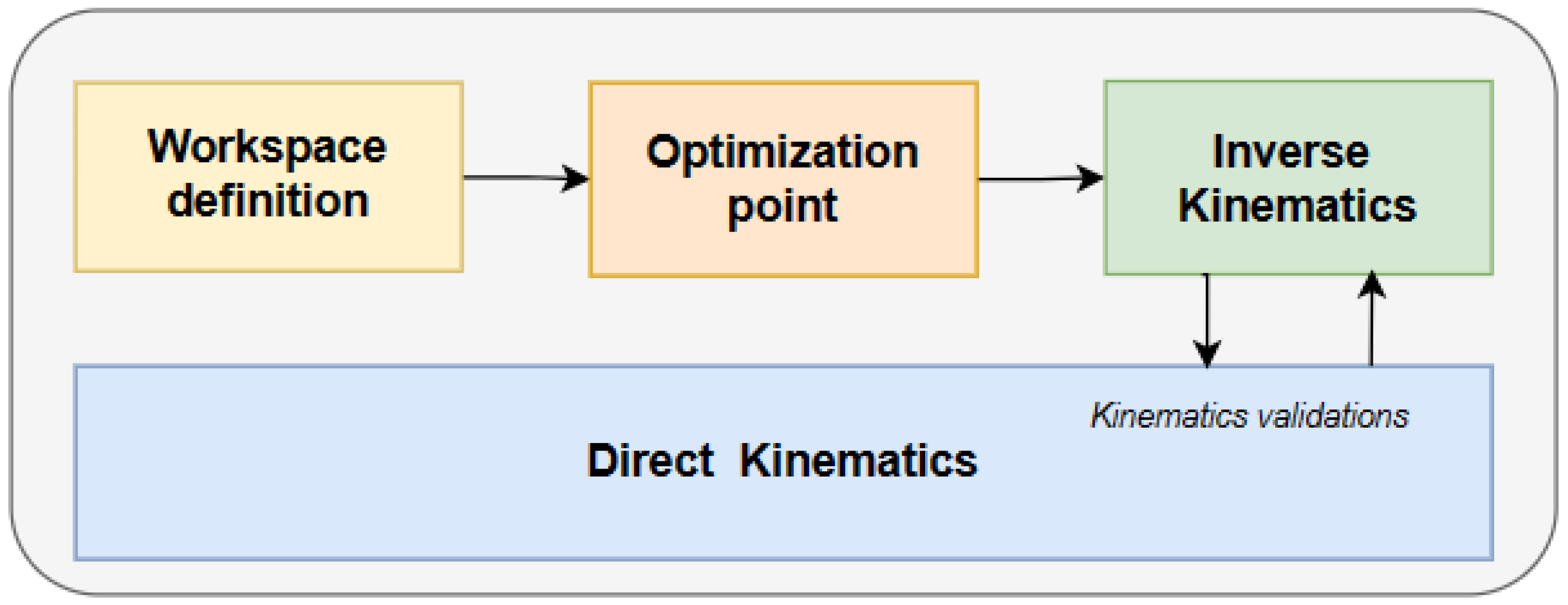
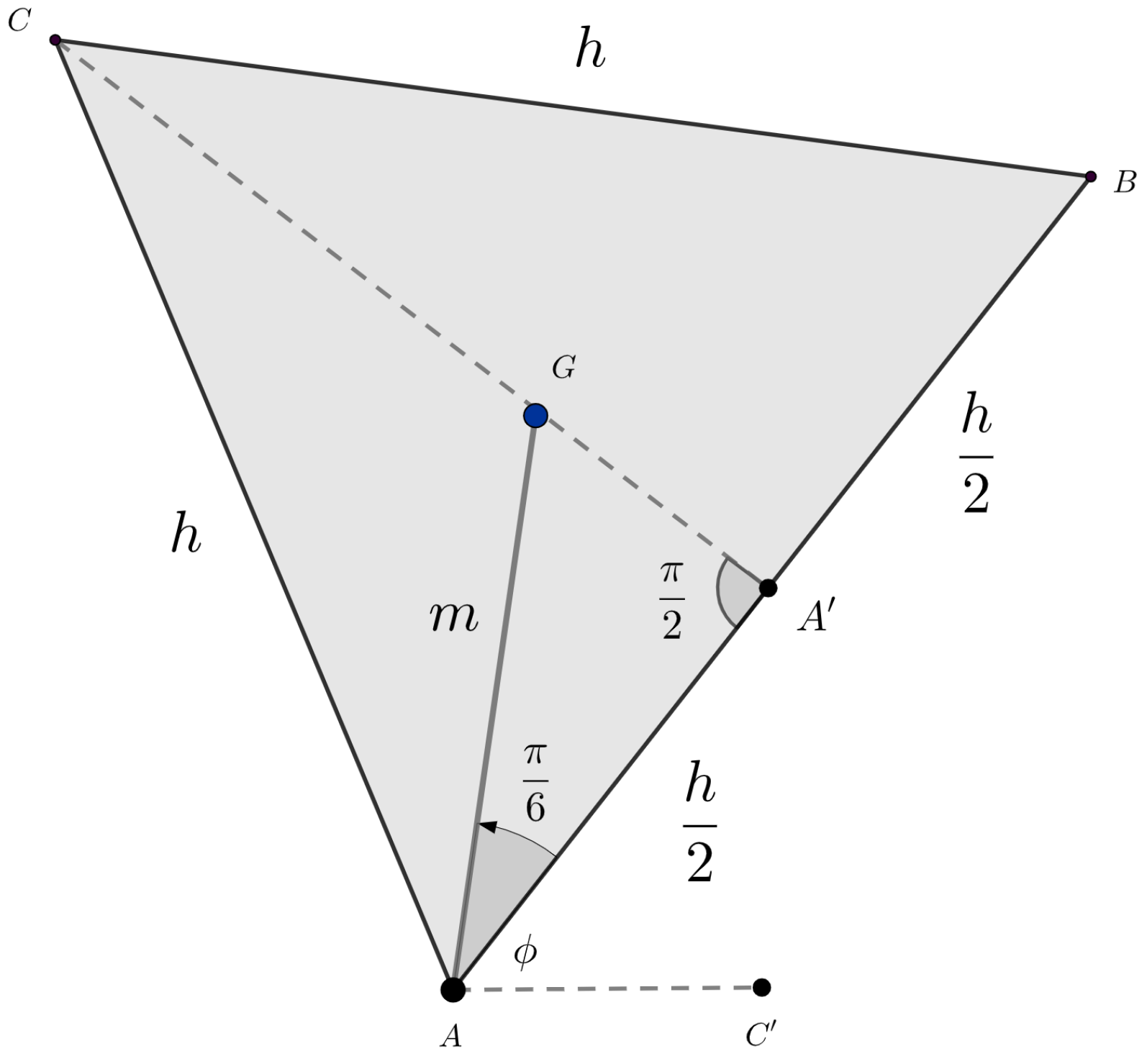
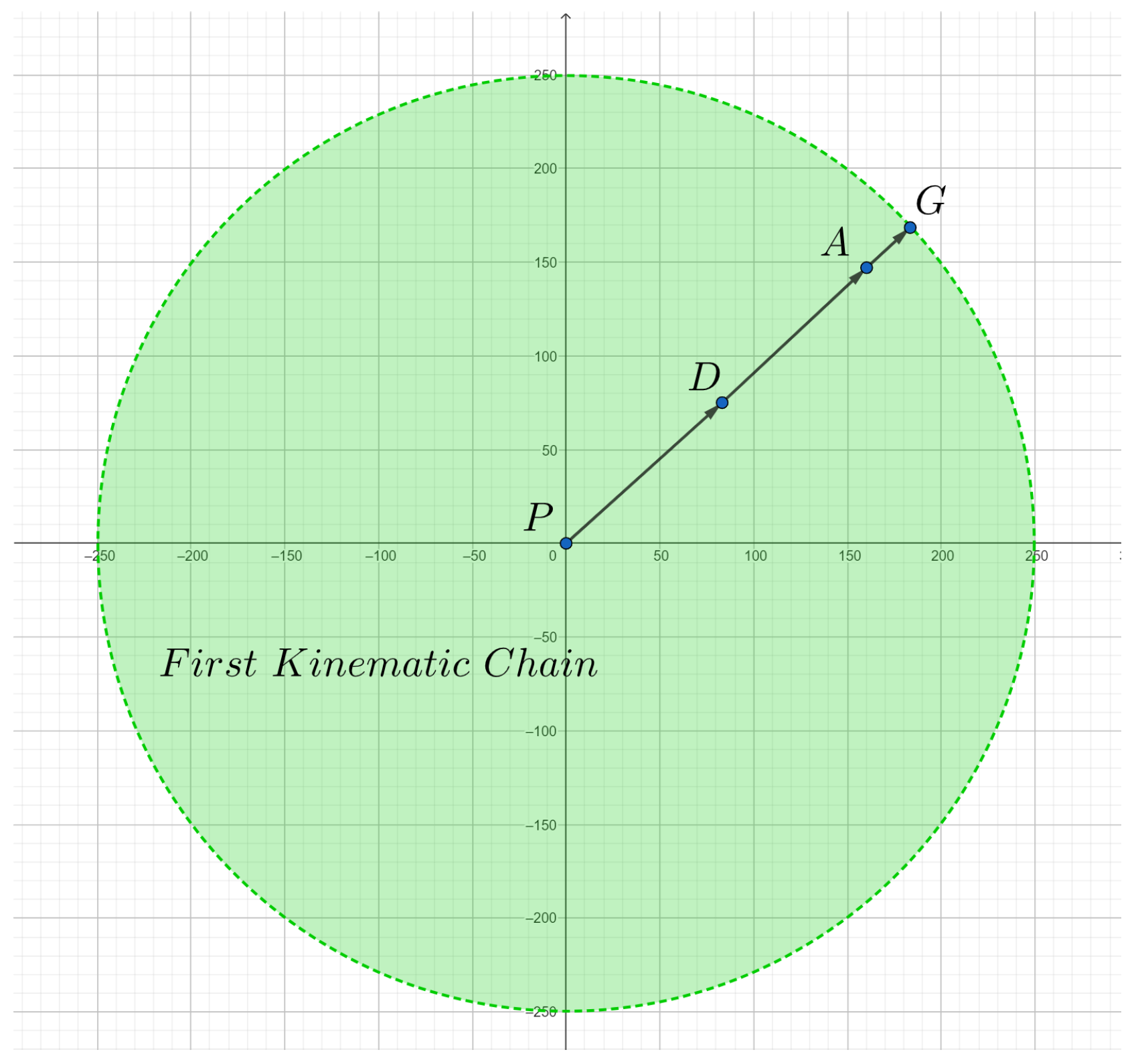
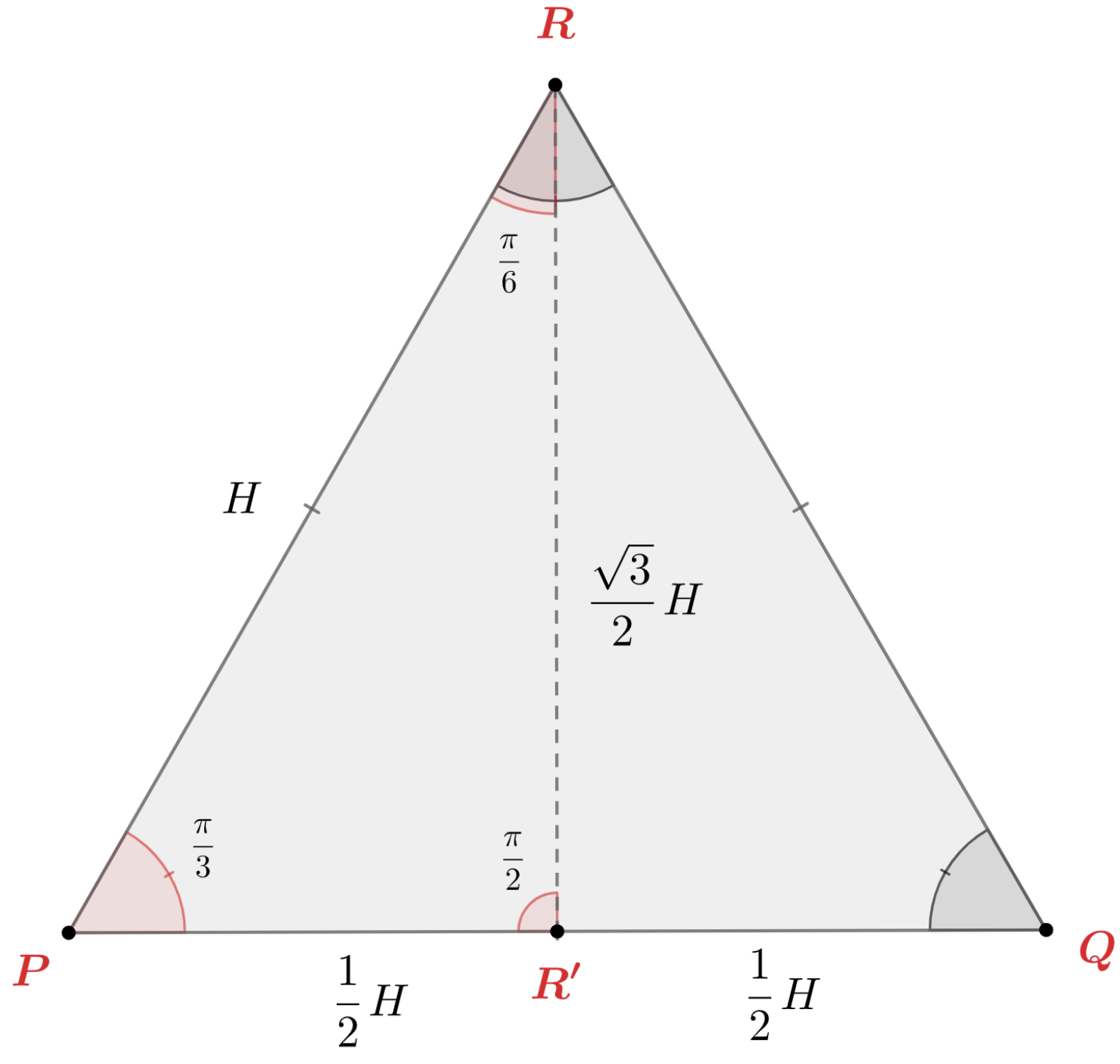


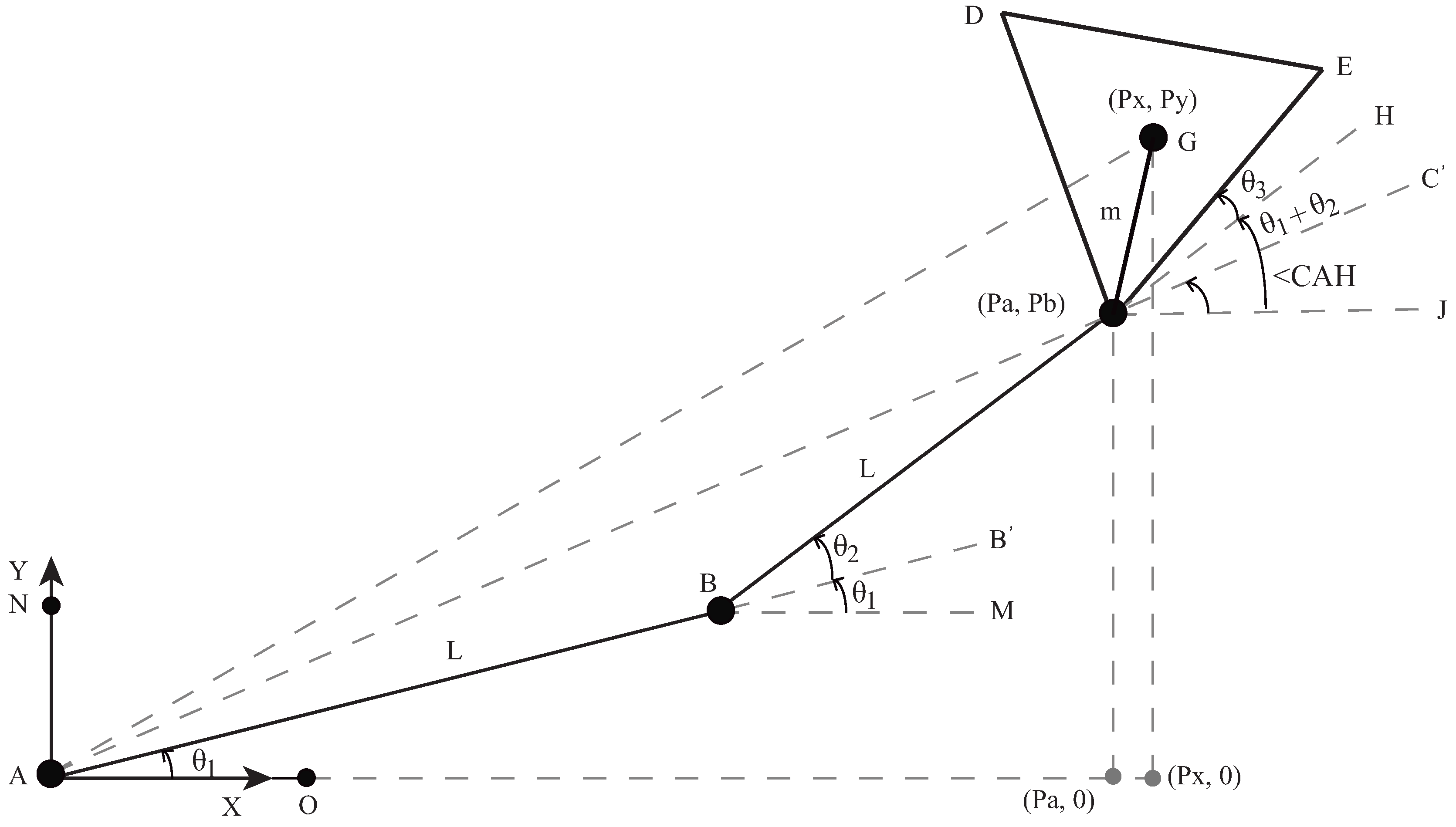

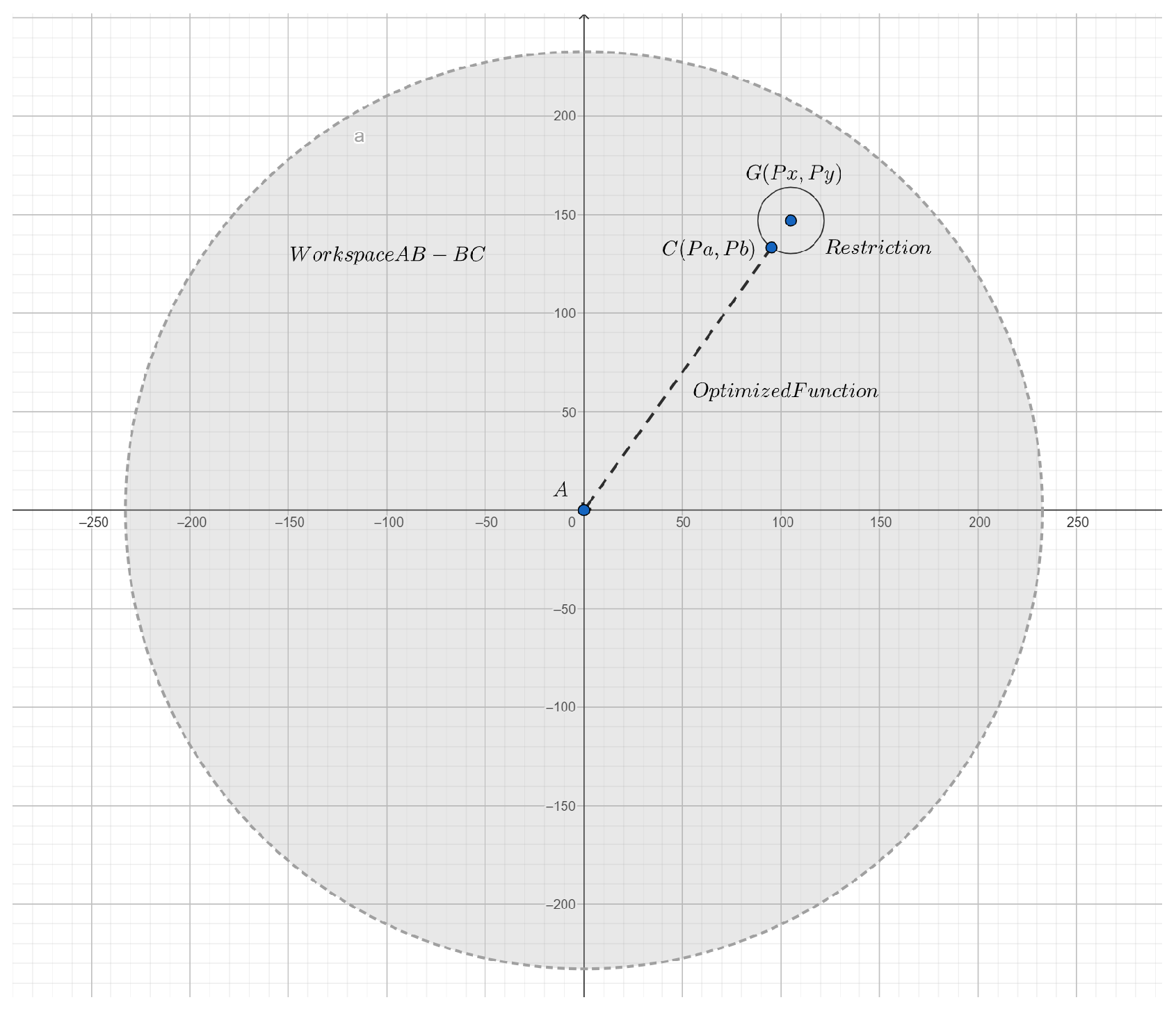

| References | Active Joints | Direct Kinematics | Inverse Kinematics |
|---|---|---|---|
| [3] | P, Q, R | N/A | Geometry Method |
| [4] | P, Q, R | N/A | Screws theory |
| [5] | P, Q, R | Geometry Method | Geometry Method |
| [6] | P, Q, R | N/A | State Variables |
| [7] | P, Q, R | N/A | Geometry Method |
| [8] | P, Q, R | Transformation matrix | Geometry Method |
| [9] | P, Q, R | Geometry Method | Geometry Method |
| [10] | P, Q, R | N/A | Geometry Method |
| [11] | P, Q, R | Numeric Method | Geometry Method |
| [12] | P, Q, R | N/A | Geometry Method |
| [22] | All Joints | Geometry Method | N/A |
| Solution | ||
|---|---|---|
| #1 | ||
| #2 | ||
| #3 | ||
| #4 |
| H | ||||||
|---|---|---|---|---|---|---|
| 250 | 125.5 | 101 | 21 | |||
| 200 | 100 | 102 | 20 | |||
| 140 | 70 | 70 | 25 | |||
| 160 | 60 | 40 | 50 | |||
| 250 | 40 | 30 | 10 | |||
| 190 | 49 | 25 | −10 | |||
| 100 | 35 | 50 | −20 | |||
| 110 | 50 | 60 | 25 | |||
| 95 | 40 | 50 | 45 | |||
| 81 | 35 | 52 | 37 |
| H | |||||
|---|---|---|---|---|---|
| 221 | 130 | 35 | |||
| 181 | 120 | 35 | |||
| 200 | 159 | 50 | |||
| 210 | 160 | 55 | |||
| 150 | 61 | 90 | |||
| 135 | 61 | 82 | |||
| 100 | 40 | 49 | |||
| 107 | 40 | 51.7 | |||
| 93 | 65.9 | 35.6 | |||
| 351 | 100 | 100 |
| Orientated | Not Orientated | |||||||
|---|---|---|---|---|---|---|---|---|
| 85 | 11 | 45° | ||||||
| 73 | 11 | 45° | ||||||
| 60 | 23 | 45° | ||||||
| 60 | 41 | 45° | ||||||
| 60 | 100 | 45° | ||||||
| 90 | 100 | 45° | ||||||
| 131 | 100 | 45° | ||||||
| 165 | 90 | 45° | ||||||
| 165 | 72 | 45° | ||||||
| 165 | 22 | 45° | ||||||
| 115 | 12 | 45° | ||||||
| 115 | 51 | 45° | ||||||
| 115 | 92 | 45° | ||||||
| 117 | 90 | 45° | ||||||
| 93 | 135 | 45° | ||||||
| 130 | 130 | 45° | ||||||
| 130 | 62 | 45° | ||||||
| 91 | 11 | 45° | ||||||
| 115 | 140 | 45° | ||||||
| 70 | 71 | 45° |
| Angle Name | Orientation | No Orientation |
|---|---|---|
| 26.06 | 24.67 | |
| 32.46 | 31.62 | |
| 22.31 | 15.81 |
Disclaimer/Publisher’s Note: The statements, opinions and data contained in all publications are solely those of the individual author(s) and contributor(s) and not of MDPI and/or the editor(s). MDPI and/or the editor(s) disclaim responsibility for any injury to people or property resulting from any ideas, methods, instructions or products referred to in the content. |
© 2024 by the authors. Licensee MDPI, Basel, Switzerland. This article is an open access article distributed under the terms and conditions of the Creative Commons Attribution (CC BY) license (https://creativecommons.org/licenses/by/4.0/).
Share and Cite
Cardona, J.J.M.; Cardona, M.; Canales-Verdial, J.I.; Ordoñez-Avila, J.L. Direct and Inverse Kinematics of a 3RRR Symmetric Planar Robot: An Alternative of Active Joints. Symmetry 2024, 16, 590. https://doi.org/10.3390/sym16050590
Cardona JJM, Cardona M, Canales-Verdial JI, Ordoñez-Avila JL. Direct and Inverse Kinematics of a 3RRR Symmetric Planar Robot: An Alternative of Active Joints. Symmetry. 2024; 16(5):590. https://doi.org/10.3390/sym16050590
Chicago/Turabian StyleCardona, Jordy Josue Martinez, Manuel Cardona, Jorge I. Canales-Verdial, and Jose Luis Ordoñez-Avila. 2024. "Direct and Inverse Kinematics of a 3RRR Symmetric Planar Robot: An Alternative of Active Joints" Symmetry 16, no. 5: 590. https://doi.org/10.3390/sym16050590
APA StyleCardona, J. J. M., Cardona, M., Canales-Verdial, J. I., & Ordoñez-Avila, J. L. (2024). Direct and Inverse Kinematics of a 3RRR Symmetric Planar Robot: An Alternative of Active Joints. Symmetry, 16(5), 590. https://doi.org/10.3390/sym16050590











